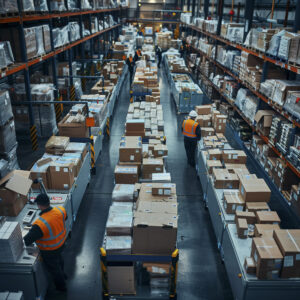Enhancing Worker Safety in Warehouses through Live Video Monitoring

Enhancing Worker Safety in Warehouses through Live Video Monitoring
In modern warehouses, worker safety is a critical concern, given the complexity of operations, the presence of heavy machinery, and the constant movement of people and products. A single oversight can lead to accidents, injury, or even fatalities. One innovative solution to mitigate these risks is live video monitoring. By integrating this technology into warehouse operations, businesses can significantly enhance safety protocols, proactively address hazards, and foster a culture of vigilance and accountability.
In this blog, we’ll explore how live video monitoring can transform worker safety in warehouses, and discuss its benefits, key features, and implementation strategies.
The Challenges of Warehouse Safety
Warehouse environments are inherently risky due to several factors:
◉ Heavy machinery: Forklifts, conveyor belts, and other large equipment pose significant dangers if not operated correctly or if workers are inattentive.
◉ Frequent movement: Workers, machinery, and vehicles are constantly on the move, increasing the chances of collisions, slips, or falls.
◉ Limited visibility: The layout of warehouses often includes shelves, corners, and tight spaces, making it difficult to maintain clear visibility across the entire facility.
◉ Hazardous materials: Many warehouses store or handle chemicals and other dangerous substances that require strict safety protocols.
◉ Manual labor: Repetitive motions, heavy lifting, and ergonomic risks are common issues for workers in warehouse settings.
These factors combine to create a high-risk environment that demands constant attention and proactive safety measures.
The Role of Live Video Monitoring in Worker Safety
Live video monitoring offers a proactive way to manage safety risks in warehouses. Here’s how:
1. Real-Time Hazard Detection
Live video feeds allow safety managers and supervisors to observe warehouse operations in real-time. This means that they can:
● Identify potential hazards before they escalate.
● Spot unsafe practices like improper lifting techniques or failure to wear personal protective equipment (PPE).
● Monitor high-risk zones, such as areas with heavy equipment or hazardous materials, ensuring compliance with safety protocols.
2. Immediate Response to Incidents
In the event of an accident or safety breach, live video monitoring allows for:
● Instant alerts to supervisors about the location and nature of the incident.
● Rapid coordination of emergency response, ensuring that injured workers receive medical attention quickly.
● Accurate incident documentation, providing video evidence that can be used for investigation and future prevention efforts.
3. Compliance Monitoring
Ensuring compliance with safety standards, whether regulatory or company-specific, is critical to preventing accidents. Live video monitoring helps by:
● Tracking worker behavior and adherence to safety guidelines.
● Recording safety violations, providing a basis for corrective action or additional training.
● Monitoring PPE use, ensuring that workers are properly equipped for the tasks at hand.
Benefits of Live Video Monitoring in Warehouses
Implementing live video monitoring in warehouses brings multiple benefits that enhance overall safety and operational efficiency.
1. Increased Accountability
Workers and supervisors are more likely to follow safety protocols when they know their actions are being monitored. This leads to:
● Better adherence to safety practices.
● Reduction in negligent behavior, such as speeding forklifts or improper handling of materials.
● Clear evidence for investigations, reducing ambiguity when incidents occur.
2. Reduced Incident Response Time
With live monitoring, incidents can be addressed in real-time, reducing the severity of injuries or damage. When an accident is detected:
● Emergency personnel can be dispatched immediately.
● Supervisors can intervene promptly, potentially stopping incidents before they worsen.
3. Enhanced Training and Improvement
By reviewing video footage of day-to-day operations, warehouses can identify:
● Common unsafe practices or recurring safety violations.
● Areas where workers need additional training.
● Opportunities to improve warehouse layouts to reduce the risk of accidents, such as adjusting forklift routes or reorganizing storage areas.
4. Cost Savings
Though the initial investment in a live video monitoring system may seem significant, it leads to long-term savings:
● Reduced workers’ compensation claims due to fewer accidents and injuries.
● Lower insurance premiums as a result of improved safety protocols.
● Avoidance of costly fines for non-compliance with safety regulations.

Key Features of an Effective Live Video Monitoring System
To achieve maximum safety benefits, a warehouse’s live video monitoring system must include several key features:
◉ High-definition cameras: Clear, detailed footage is essential for accurately assessing situations and identifying hazards.
◉Wide-angle and PTZ cameras: Wide-angle cameras cover large areas, while pan-tilt-zoom (PTZ) cameras provide the flexibility to focus on specific zones or incidents.
◉24/7 monitoring: Warehouses that operate around the clock need continuous monitoring to ensure safety at all times.
◉Integration with sensors and alarms: Combining video monitoring with sensors for smoke, temperature, or motion can provide early warning of potential hazards.
◉Cloud-based storage: Storing video footage in the cloud ensures that it is easily accessible and securely backed up for future reference or review.
◉AI-powered analytics: Modern systems can use artificial intelligence to detect anomalies, such as unrecognized individuals or abnormal behaviors, and alert supervisors automatically.
 Steps to Implement Live Video Monitoring in Warehouses
Steps to Implement Live Video Monitoring in Warehouses
For warehouses considering the adoption of live video monitoring to enhance worker safety, here are key steps to ensure successful implementation:
1. Assess Current Safety Risks
o Identify high-risk areas, such as loading docks or areas with heavy equipment, and prioritize them for monitoring.
o Evaluate the warehouse layout to determine optimal camera placement for maximum visibility.
2. Choose the Right System
o Select a video monitoring system that meets the unique needs of the warehouse, including camera types, monitoring software, and integration capabilities with other safety systems.
o Ensure the system complies with any industry-specific regulations or safety standards.
3. Train Staff
o Train warehouse supervisors and safety personnel on how to effectively use the monitoring system.
o Ensure that workers understand the purpose of the cameras and how the system contributes to their safety.
4. Monitor and Review Regularly
o Establish a regular schedule for reviewing video footage, especially following incidents or near-misses.
o Use video evidence to continually improve safety protocols, retrain workers, and make necessary adjustments to operations.
5. Engage Workers in Safety Culture
o Encourage workers to report unsafe practices or conditions, and use video footage to support a transparent and proactive safety culture.
o Use the monitoring system to recognize and reward safe behavior, reinforcing positive actions.

Conclusion
Enhancing worker safety in warehouses is a constant challenge, but live video monitoring offers a powerful tool to address risks proactively and in real time. By investing in a comprehensive video monitoring system, warehouses can not only reduce accidents and injuries but also improve overall operational efficiency and accountability. When combined with a strong safety culture and ongoing worker training, live video monitoring becomes an indispensable asset for any warehouse looking to safeguard its workforce.
By staying ahead of potential hazards, warehouses can protect their workers, minimize costs, and ensure smooth, safe operations.
Thank you for exploring the benefits of live video monitoring and how it’s used to protect your assets! If you’re interested in learning more about how these cutting-edge technologies can enhance the security and operations of your business, or if you’re ready to schedule a consultation for live video monitoring, don’t hesitate to reach out to us at REMOTE ALLY in Los Alamitos, CA. Our team of experts is here to provide personalized solutions tailored to your unique needs. Contact us today at 866-439-0318 or via email at [email protected]. Let’s work together to create a safer and more secure environment for your business.
Images Designed by Freepik


